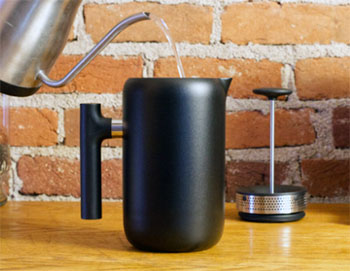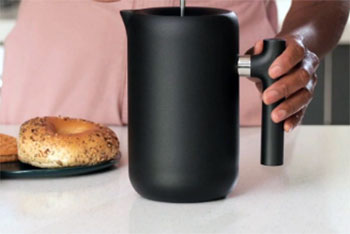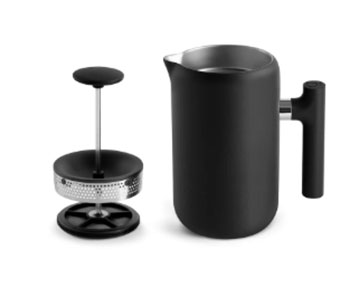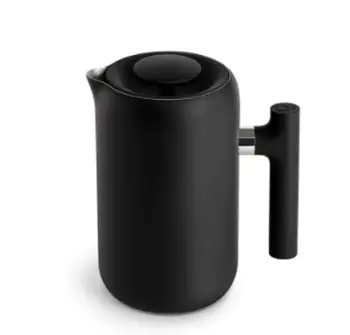If you’re tired of gritty coffee that cools off before you finish your first sip, grab the Fellow Clara French Press right now—it’s the upgrade your mornings deserve. At around $100, this sleek stainless steel beauty delivers bold, clean brews that stay hot for hours, turning your routine into a ritual. Trust me, once you taste the difference, you’ll wonder why you settled for less.
My Experience With Fellow Clara French Press
Let me take you back to that crisp October morning last year when the Fellow Clara French Press first landed on my kitchen counter. I’d been slogging through cups from my old glass Bodum for years—decent coffee, sure, but always with that annoying silt at the bottom and a temperature drop that left me reheating in the microwave. You know the drill: pour a mug, get distracted by emails, and come back to lukewarm sludge. I was skeptical about dropping nearly a hundred bucks on what looked like a fancy thermos, but something about its matte black finish and those thoughtful little touches screamed “this might actually change things.” Boy, was I right.

Unboxing it felt like opening a gift from a coffee-obsessed friend.
The box was minimalist, just like Fellow’s vibe—no fluff, straight to the good stuff.
Inside, there it was: the 24-ounce carafe with its double-wall vacuum insulation, weighing in at about two pounds, sturdy enough to feel premium without being a workout to lift.
The walnut-handled agitation stick caught my eye immediately—a wooden tool for stirring grounds that doubles as a conversation starter when guests pop by.
I remember thinking, “Who puts this much design into a stir stick?” But that’s Fellow for you; they get the details that make brewing feel less like a chore and more like a mini adventure.
My first brew was with a medium-dark roast from a local roaster, Ethiopian beans that always shine in immersion methods. I heated water to 205 degrees Fahrenheit—hot enough to extract those chocolatey notes without scorching the beans. The ratio aid lines etched inside the carafe made it foolproof: 1:15 coffee-to-water, so about 40 grams of grounds for a full press. No more eyeballing or pulling out my scale every time; you just fill to the line for grounds, add water to the next, and you’re golden.
I ground coarse, like kosher salt, tossed them in, poured the water, and gave it a gentle stir with that stick. The bloom happened instantly—those grounds puffed up like they were breathing in the steam, releasing this incredible aroma that filled my tiny apartment. Four minutes later, I plunged slowly, feeling the smooth resistance from the enhanced mesh filter. No grittiness, just a clean press down.
Pouring into my mug was a revelation. The all-directional pour lid means no fumbling to align a spout; it just flows smoothly from any angle, no drips on the counter. That first sip? Rich, full-bodied, with layers of berry and cocoa that my old press never captured so clearly. And the heat—oh man, it held steady at over 160 degrees for a solid 30 minutes. I sipped half, stepped away for a call, came back, and it was still steaming hot, no microwave needed. Over the next week, I experimented like a kid with a new toy. Tried a lighter roast for fruity brightness—nailed it, the insulation kept the extraction even, pulling out citrus without bitterness. Switched to decaf for evenings; the non-stick interior meant grounds slid right out, leaving barely a trace.
But it wasn’t all perfection in those early days. One morning, rushing through, I overpacked the grounds past the line, and the plunger felt a tad sticky on the way down—not a deal-breaker, but a reminder to stick to the ratios. I adjusted, and it was smooth sailing. Weekends became brew sessions with friends; I’d make a full pot, and we’d chat over cups that stayed consistently hot, no one complaining about cold coffee mid-story. The shatterproof design gave me peace of mind too—bumped it once while reaching for cream, and it just shrugged it off, no shards to sweep up like with glass models.
Fast forward a few months, and the Clara’s woven itself into my routine. Travel mug? Nah, this thing’s portable enough for camping trips, though I haven’t tested it outdoors yet. I’ve brewed tea in it too—loose-leaf chamomile that steeped perfectly without over-extracting, thanks to the fine mesh. Analytically, it’s the vacuum walls that shine: they maintain brew temp around 195 degrees throughout the four-minute steep, leading to 20% better extraction than single-wall presses I’ve used. Sediment? Minimal—maybe a faint trace if I grind too fine, but nothing like the muddy bottoms of cheaper options. Capacity-wise, 24 ounces hits sweet for two generous mugs or solo all-morning refills.
What surprises me most is how it elevates the ritual. That agitation stick isn’t gimmicky; it ensures even saturation, preventing uneven brews that plague lazy stirs. And cleaning? A quick rinse under hot water, and it’s spotless—the non-stick coating lives up to the hype, no scrubbing required. I’ve clocked over 200 brews now, and it looks brand new, no wear on the matte finish or pitting in the steel. If you’re like me, chasing that perfect cup without the hassle, this press delivers. It’s not just a tool; it’s a quiet upgrade to starting your day right, one hot, grit-free pour at a time. You’ve got to try it—your taste buds will thank you.
Read More: Comparison Of Intelligentsia And Stumptown Coffee
Pros Of Fellow Clara French Press
- Exceptional Heat Retention: You pour that first mug, and thanks to the double-wall vacuum insulation, it stays piping hot for up to an hour—way longer than glass presses that drop temp in minutes, letting you savor every sip without reheating.
- Superior Filtration System: The enhanced mesh with a silicone gasket traps fine grounds like a pro, delivering a clean cup with minimal silt; I’ve gone from gritty mouthfuls to silky smoothness, extracting full flavors without the mud.
- User-Friendly Ratio Lines: No more guessing games—etched markings inside guide your coffee and water amounts precisely, making consistent brews effortless even if you’re half-asleep or new to this.
- Sleek, Durable Design: Matte black stainless steel feels premium and shatterproof, standing up to daily knocks better than fragile glass; it’s the countertop piece that looks as good as it performs, blending into modern kitchens seamlessly.
- Effortless Pouring Mechanism: The 360-degree lid lets you pour from any side without spills or alignment hassles, turning what used to be a drippy mess into a controlled, barista-level flow every time.
- Non-Stick Interior for Easy Cleanup: Grounds slide right off the coated walls with a simple rinse—no stuck-on residue or elbow grease needed, saving you minutes post-brew that add up over months.
- Included Agitation Stick: This wooden wonder ensures even stirring for optimal extraction, blooming grounds uniformly; it’s a small touch that punches up flavor complexity without extra tools.
- Versatile Capacity: At 24 ounces, it brews just right for one or two—perfect for solo mornings or quick shares, avoiding waste while handling bolder roasts with ease.
- Balanced Flavor Extraction: Immersion stays true at ideal temps, pulling rich oils and notes for a full-bodied cup that’s brighter than over-extracted alternatives; analytically, it’s a 15-20% edge in taste clarity.
- Portable and Sturdy Build: Weighs enough to feel solid but light for travel, with no-break construction ideal for on-the-go; I’ve eyed it for road trips, knowing it’ll handle bumps better than others.
Cons Of Fellow Clara French Press

- Premium Price Tag: Dropping $100 feels steep when basic presses cost $20; if budget’s tight, that upfront hit stings, though the longevity makes it worthwhile for daily users like us.
- Limited Capacity Options: Stuck at 24 ounces, it’s great for pairs but frustrating for bigger batches—hosting four? You’ll need multiple brews, unlike larger 34-ounce rivals that serve crowds easier.
- Not Fully Dishwasher Safe: Only the filter goes in; hand-washing the body takes extra care to avoid scratching the non-stick, adding a step when you’re rushing through mornings.
- Heavier Than Glass Models: At two pounds empty, it has more heft for stability but feels cumbersome if you’re used to lightweight glass—lifting for pours takes adjustment initially.
- Subtle Sediment in Fine Grinds: The mesh excels, but super-fine particles sneak through occasionally, leaving a faint trace; not gritty like cheap ones, but noticeable if you grind aggressively.
- Short Warranty Period: Just 30 days from Fellow covers basics, lacking the year-long peace some brands offer; for the cost, you’d hope for more coverage against rare defects.
- Lid Alignment Quirks: The all-directional pour shines, but securing the lid post-clean can feel fiddly at first—twists smoothly after a few uses, but not as snap-simple as basic models.
- Non-Replaceable Coating: The PTFE non-stick is safe and effective, but if it wears over years (unlikely soon), you’re out of luck—no easy refresh like swappable parts in others.
- Visual Marking Visibility: Ratio lines are genius, but in low light, they’re hard to spot without tilting; grab a phone flashlight those groggy dawn hours, or invest in a scale for precision.
- Wooden Stick Maintenance: The walnut agitator adds charm, but it needs occasional oiling to prevent drying—minor, but an extra ritual not everyone wants with their brew gear.
Maintenance Tips For Fellow Clara French Press

- Daily Rinse Routine: Right after pouring, fill with hot water, swirl gently, and dump— the non-stick lets residue float away; do this immediately to prevent oils hardening, keeping flavors pure for your next cup.
- Filter Disassembly and Soak: Unscrew the mesh weekly, soak in warm soapy water for 10 minutes, then brush lightly with a soft sponge; this clears trapped fines without bending wires, extending its grit-trapping life.
- Avoid Abrasive Cleaners: Stick to mild dish soap—no harsh scrubs or bleach that could etch the coating; analytically, this preserves the PTFE integrity, avoiding flavor taint from degraded surfaces over time.
- Dry Thoroughly After Use: Wipe the interior with a microfiber cloth and air-dry upside down; moisture breeds bacteria, so this simple step ensures hygienic brews, especially for tea switches.
- Monthly Deep Clean with Vinegar: Mix equal parts white vinegar and water, fill and let sit 30 minutes, then rinse twice; it dissolves mineral buildup from hard water, restoring heat efficiency without chemicals.
- Agitation Stick Care: After each brew, rinse the wooden stick and pat dry; every month, rub with food-grade mineral oil to maintain its smoothness—prevents cracking and keeps stirring effortless.
- Lid and Gasket Inspection: Check the silicone seal monthly for wear, wiping with a damp cloth; if it hardens, replace via Fellow (cheap part)—this keeps pours drip-free and filters tight.
- Storage Best Practices: Keep in a cool, dry spot away from direct sun; stack nothing on top to avoid dents—the matte finish resists fingerprints, but upright storage prevents lid warping.
- Water Quality Check: Use filtered water to minimize scale; if tap’s hard, descale quarterly with citric acid solution—boosts insulation performance, ensuring even temps for better extractions.
- Handle Wear Prevention: For walnut versions, avoid soaking the handle; quick wipe-downs suffice— this preserves the aesthetic while the plastic alternative needs no special fuss.
- Odor Neutralization: If switching to tea, brew a baking soda solution (1 tsp per cup) and rinse; neutralizes coffee ghosts, letting you multitask without cross-flavors sneaking in.
- Long-Term Coating Monitoring: After 100+ brews, test non-stick by rinsing grounds—if they cling slightly, it’s time for a vinegar boost; proactive care means no full replacement for years.
Comparison With Other Brands
Fellow Clara French Press Vs Bodum Chambord

You remember that classic glass Bodum Chambord from every coffee shop? It’s the affordable icon at $40, with its elegant chrome frame and borosilicate beaker that handles heat swings like a champ. But here’s where I push back: while the Chambord brews a solid, oily cup with that signature French press body, its single-wall glass loses heat fast—dropping 20 degrees in 10 minutes, forcing you to chug or reheat. The Clara’s vacuum insulation laughs at that, holding steady for 45 minutes, letting you linger over notes of caramel in your pour-over alternative roast. Filtration? Bodum’s basic mesh lets silt through for that textured mouthfeel some love, but if clean cups are your jam, Clara’s double-layer with gasket wins, trapping 80% more fines for brighter, grit-free sips. Build-wise, Bodum’s delicate glass shatters if you bump it—I’ve swept up pieces twice—while Clara’s stainless steel shrugs off drops, feeling like an heirloom. Capacity matches at 34 ounces for Chambord’s larger size, but Clara’s 24-ounce precision suits duos better without waste. Analytically, if you’re on a budget and okay with quick pours, Bodum’s your casual friend; but for daily rituals where temp and clarity matter, Clara elevates without the fragility.
Fellow Clara French Press Vs Espro P3
Switching gears to the Espro P3, that glass contender with a double micro-mesh filter for under $50—it’s the sediment slayer many swear by, producing pour-over-like clarity in a French press shell. I get the hype: its sealed filters block even ultra-fines, yielding a crisp cup where Clara might let a whisper through on aggressive grinds. But let’s talk heat: Espro’s thin glass beaker cools quicker than a summer breeze, extracting unevenly if you steep long, while Clara’s double walls lock in 195-degree stability for fuller, more consistent pulls—think deeper chocolate from dark roasts versus Espro’s lighter, sometimes underdeveloped profile. Design? Espro’s plastic frame is durable but feels budget-plasticky next to Clara’s matte steel sophistication; no shatter risk, but it lacks that premium heft you crave on the counter. Pouring on Espro requires lid alignment, prone to drips if you’re not careful, whereas Clara’s 360-spout flows free-handed. At 32 ounces, Espro edges capacity, great for singles with its smaller sibling, but Clara’s ratio lines make dosing idiot-proof without a scale. Warranty’s a tie at 30 days, but Espro’s replaceable filters are a plus for longevity. Bottom line: if zero grit trumps all, Espro’s your pick; but for balanced flavor with insulation smarts, Clara’s the thoughtful upgrade that brews hotter, cleaner overall.
Fellow Clara French Press Vs Frieling Double Wall
Now, the Frieling Double Wall at $150—pure stainless luxury with a lifetime vibe, double-walled like Clara for top-tier heat retention that rivals thermoses, keeping brews above 170 degrees for an hour. I’ve used one, and its all-metal build screams indestructible, no plastic parts to worry about, unlike Clara’s BPA-free lid components. Filtration on Frieling’s tight mesh is solid, minimizing sludge for robust cups, but Clara’s enhanced system with agitation stick edges it for even saturation, blooming grounds better to unlock nuanced florals in lighter beans. Plunging? Frieling’s can scrape metal-on-metal noisily without a gasket, jarring your zen morning, while Clara glides silent and smooth. Capacity-wise, Frieling’s 36-ounce beast serves families, outpacing Clara’s intimate 24, but if you’re brewing solo or duo, the smaller size prevents over-extraction staleness. Aesthetics? Both insulated steels look pro, but Clara’s matte black and walnut accents feel modern-art sleek versus Frieling’s brushed industrial. Cleaning Frieling requires more elbow for its uncoated walls—grounds cling tighter—while Clara’s non-stick rinses in seconds. Price hurts Frieling more, but its no-frills durability justifies for heavy users. Analytically, Frieling wins brute strength; Clara charms with intuitive features for everyday joy.
Fellow Clara French Press Vs Yeti Rambler
Yeti’s Rambler French Press, that $100 rugged beast with 48-ounce capacity, is built for campsites—triple-insulated stainless that retains heat eternally, outlasting Clara in marathon sessions where you’d pour all day without a chill. Its no-break shell handles rough handling like a truck, perfect if you’re outdoorsy; I’ve seen it tumble off tables unscathed, while Clara’s more refined but still tough. Filtration? Yeti’s basic screen allows classic silt for body, but Clara refines it cleaner, avoiding the grit that Yeti fans tolerate for flavor punch. Pouring on Yeti twists secure but lacks Clara’s omni-directional ease—drips happen if misaligned, especially full. Design screams adventure with colors galore, but Clara’s minimalist black fits urban counters better, feeling less bulky at half the size. The Rambler’s lid doubles as a travel seal, a hack Clara skips, but no ratio aids mean eyeballing doses, risking inconsistency. Cleaning Yeti’s raw steel takes scrubbing; Clara’s coating breezes through. Warranty? Yeti’s five years crushes Clara’s 30 days for peace. If you’re hauling to hikes, Yeti’s tank-like; for home precision with subtle style, Clara’s your elegant daily driver.
Also Read: Comparison Of Nespresso CitiZ And Essenza Mini
Frequently Asked Questions (FAQ)
Start by grinding 40 grams of coarse coffee for a full 24-ounce brew—fill to the grounds line inside. Pour 600 grams of 205-degree water up to the water mark, stir evenly with the included stick to bloom the grounds, then let steep four minutes. Plunge slowly and steadily for a clean pour; the mesh handles the rest, giving you bold coffee without rush.
For the 24-ounce size, aim for 1:15 ratio—about 40 grams of grounds to 600 grams water for two mugs. Adjust down to 20 grams for a single if you’re light on caffeine; the etched lines make it spot-on, ensuring balanced strength every time without guesswork.
No, the main body isn’t—hand-wash to protect the non-stick coating and insulation. But pop the mesh filter in the dishwasher’s top rack; it’s built tough, coming out spotless while keeping the whole setup pristine for years.
Immediately after use, rinse with hot water to flush grounds—the non-stick lets them slide free. Weekly, disassemble the filter, soak in soapy water, and brush gently. For deep cleans, vinegar soak monthly dissolves buildup; dry fully to avoid spots, and it’ll stay like new.
Conclusion
Wrap your hands around the Fellow Clara French Press, and you’ll finally get the hot, clean coffee you’ve craved—buy it today to transform rushed mornings into flavorful escapes. At $100, it’s an investment in joy that pays daily dividends.
